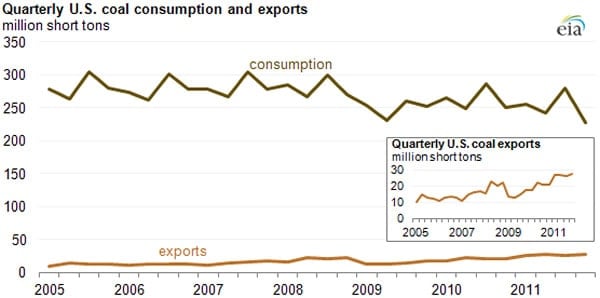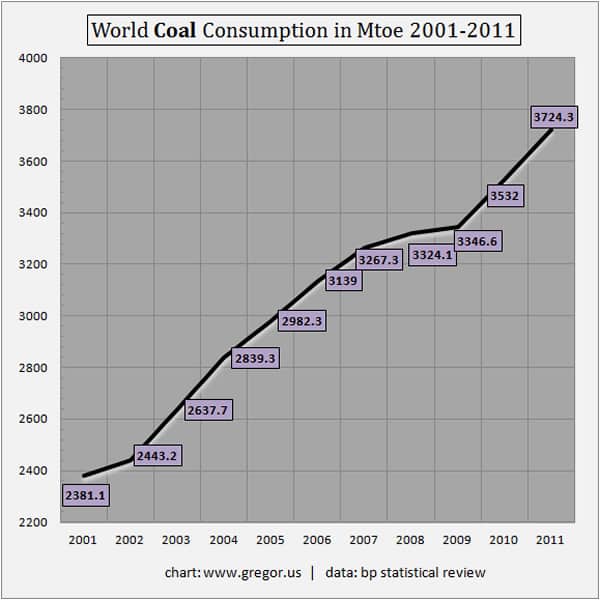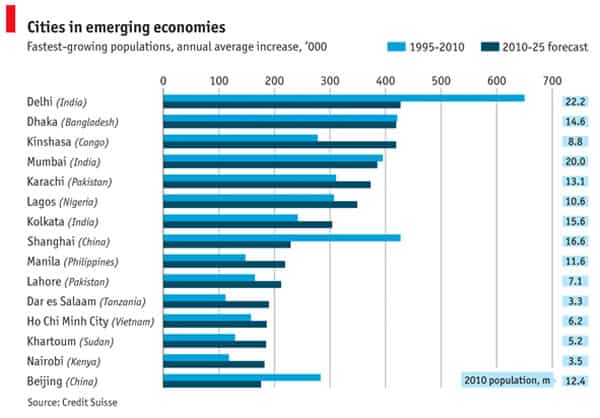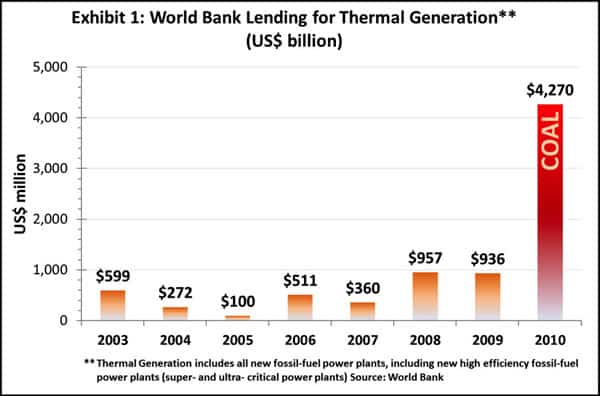Oil, natural gas, and alternatives dominate the headlines when it comes to energy. But there's a big and largely-overlooked revolution occurring with the energy source likely to become the most preferred fuel for a world in economic decline: coal.
The United States coal sector has been hit very, very hard this spring. Demand has been crushed by over 10%, as warm weather and bountiful supplies of cheap natural gas have induced power plant operators and all other users where possible to switch away from domestic coal. The rapid change in fortune has sent the stock prices of big, listed names such as Peabody and Arch down by double digit percentages, as the Dow Jones US Coal Index has fallen below 160 from above 225 at the start of 2012.
From Bloomberg:
Central Appalachian thermal coal futures, the U.S. benchmark, averaged $60.20 during the first quarter, down from an average of $73.58 in the year ago period and down from a high of $143.25 in July 2008. “It’s like a perfect storm,” Mann said. “The three main challenges are the really mild winter, a lethargic economy and on top of that, with gas prices being so low, those utilities that can burn gas have opted to burn gas instead of coal because gas is so cheap.” Cheap gas has undercut power producers’ revenues because it drives down wholesale electricity prices, squeezing margins for plants that run on nuclear, renewable and coal power. Moody’s Investors Service changed its outlook for the U.S. coal industry to “negative” from “stable” on May 7, citing weak prices and a drop in power demand, and said it expects a 5 percent decline in prices for coal deliveries in 2013. The U.S. Energy Information Administration expects the industry to see a 10.9 percent decline in coal consumption this year and Moody’s expects U.S. coal demand from power plants to plunge by 100 million tons by 2020, the ratings company said in the report.
(Source)
Given the rather weak near-term and long-term outlook for US coal demand, it’s not surprising that within such a capital-intensive business, a number of smaller coal producers were hit recently with bankruptcy rumors. Indeed, even large cap names like Arch Coal have seen an escalation of concern over debt levels. Accordingly, many have concluded that coal -- in an era of solar, wind, and natural gas -- has finally displaced itself due to its problematic extraction, distant transportation, and overall costs. Is coal finally going away as an energy source?
Not a chance.
Indeed, everything currently unfolding for coal in the United States is precisely what is not unfolding for coal globally. Prices to import natural gas to most countries via LNG remain sky-high, easily protecting coal’s cost advantage. And the demand for coal in the developing world remains gargantuan. Accordingly, just as with oil, lower US demand simply frees up supply to elsewhere in the world.
The global coal juggernaut rolls onward.
Soaring US Exports
In the same way that falling US oil consumption has freed up global supply, so now is US declining coal demand freeing up production for export. Last year marked a twenty-year high in US coal exports:
For the full year of 2011, the US exported 107,259 thousand short tons of coal. This was the highest level of coal exports since 1991. More impressive: exports recorded a more than 25% leap compared to the previous year, 2010. (see data here, opens to PDF). Additionally, this was also a dramatic breakout in volume from the previous decade, which ranged from 40,000 – 80,000 thousand short tons per annum.
(Source)
The United States remains a large consumer of coal, and currently places second, behind China, in the top global users, which I call the Coal 7: China, USA, India, Japan, Russia, South Africa, and Germany. Accordingly, this means that the US, which currently consumes about 15% of total global demand, is about to become a marginal new source of global supply.
Although most grades of coal are still trading at a cheaper price level than a similar equivalent amount of BTUs sourced from natural gas, the all-in costs of burning coal in the United States given our regulatory framework is now higher than burning natural gas. In one sense, this is not a new story. Indeed, the advent of the Environmental Protection Agency in 1970 and the historic wave of pollution regulations set the United States on a course away from coal and towards natural gas over 40 years ago. Even the coal industry is eager to advertise the long decline of coal-fired pollution (as a portion of the whole) in the United States, which is due overall to an increase in emissions control, but is mostly the result of the rise of natural-gas-fired power since the early 1970s.
Global Coal Picture
What has changed, however, is that coal is the preferred energy source of the developing world.
In addition, as the Organisation for Economic Co-operation and Development (OECD) has shifted its manufacturing to the developing world over the past few decades, coal has been the cheap energy source that has powered the rise of such manufacturing, especially in Asia. Accordingly, the extraordinary increase in global coal consumption the past decade is partly due to the OECD offshoring its own industrial production. How are most consumer goods made? Using electricity in developing world manufacturing centers, generated by coal.
Only a very small portion of the global public is aware that global coal consumption has advanced by over 50% in the past decade. According to data from the just-released BP Statistical Review, from 2001 through 2011, global consumption of coal rose an astonishing 56%. Using the energy unit Mtoe (million tonnes oil equivalent), global coal consumption rose 1,343 Mtoe, from 2,381 to 3,724 Mtoe. And this trend shows no sign of slowing down.
Additionally, this advance contrasts greatly with the flattening of global oil production and thus the slowdown in global oil consumption. Oil's price revolution has killed a great deal of oil demand. But few are aware that while oil has fallen as a portion of primary world energy supply, coal has stormed to prominence. This is why the export of US coal, and world trade in coal, still has room to run.
Coal Hunger: It’s Not Just China
Coal consumption in the robust Indian economy has grown rapidly in recent years, averaging 8.5% per year in 2006-10 according to EIA data, including growth of 10.8% in 2010. Although we have slightly reduced our 2012-13 growth forecasts for India in light of global developments, the economy is still expected to grow by around 8% per year. Coal consumption is therefore expected to continue to rise strongly, boosted by the long-term plan to increase thermal power-generation capacity in an effort to increase access to electricity in rural areas. In its new five-year plan for the period 2012-17 the Indian government envisages that the rate of annual demand growth could stay at around 8%.
(Source: World Coal: The IEU’s Monthly Outlook, via The Economist Intelligence Unit)
2008 saw the crossing of a major milestone in humanity’s march towards industrialism, when, for the first time ever, more than 50% of the world’s population became urban.
This great migration from the countryside to the cities, which is happening in Africa, Asia, and the Middle East, is a primary driver for coal demand, as millions of new city dwellers take their place in the power grid. This recent table of projected urban population growth rates from the Economist, in its piece on Emerging Market Cities, demonstrates that an enormous phase of change still lies ahead:
The world continues to marvel at the growth rates seen in Chinese cities, like Shanghai, which is expected to add over 200,000 new residents per year in the 15-year period from 2010 to 2025. Such a pace will grow the Shanghai population from its 2010 level of 16.6 million residents to at least 19.6 million residents. However, the growth rates of urbanization are even faster in emerging mega-cities such as Kinshasa, Lagos, Karachi, Dhaka, Mumbai, and of course, Delhi. As Mike Davis writes in his terrific book, Planet of Slums:
Ninety-five percent of this final buildout of humanity will occur in the urban areas of developing countries, whose populations will double to nearly 4 billion over the next generation…The scale and the velocity of Third World urbanization, moreover, utterly dwarfs that of Victorian Europe. London in 1910 was seven times larger than it had been in 1800, but Dhaka, Kinshasa, and Lagos today are each approximately forty times larger than they were in 1950.
(Source)
Despite the fact that the developing world has indeed increased its demand for oil, thus taking nearly 100% of the supply freed up by weak OECD economies, the economies of the developing world are largely running not on liquid BTUs, but rather on BTUs from coal.
Coal’s versatility, in that it can be stored cheaply and transported via ship, rail, truck, or in smaller quantities by small personal transport, makes it the logical energy choice for the developing world. (This is not to say that wind and solar do not also make sense in non-OECD nations. Indeed, the fast pace of growth in renewables in the developing world is astonishing as well). Most important is that the cheap price of coal, especially when burned without environmental regulations, aligns with developing world wages.
For those concerned with climate change, this is, of course, terrible news. However, many of the world’s international organizations, from the International Energy Agency in Paris to various OECD policy-making groups, remain very focused on making sure that developing world nations get access to electricity. There is a strong view and strong agreement among Western policy makers that working to ensure that the world’s poor have access to electricity is the most transformative action to pull humanity out of poverty. Surely this is why the World Bank has been investing heavily in coal-fired power production. From World Bank Invests Record Sums in Coal, via The Ecologist.
(Source)
Rebounding Into Coal
The financial crisis period of the past five years has served to highlight the new and constant restraint that oil prices place on the world economy. What’s over now is the fast growth made possible by cheap, liquid BTU (oil). But this is precisely why the economies of the non-OECD continue to increase their coal consumption, and why the world economy -- when it advances -- rebounds into coal.
There are enough BTUs from natural gas and coal to fund global economic growth for years to come. If natural gas from North America was exportable right now, then world prices for Liquefied Natural Gas (LNG) would be much lower than the $14-$18 level seen from Europe to Asia. Instead, North American natural gas remains landlocked and will remain so until export facilities are completed. This makes for a highly irregular pricing landscape in natural gas, in which Americans pay $2.50 for a million BTUs of natural gas, while heavy importers like Japan can pay as much as $17.00 per million BTUs. Accordingly, it is coal and not natural gas that provides the converged pricing to the world market. And with thermal coal trading around $2.50 - $3.50 per million BTUs, the continuing transition to coal is unstoppable.
In Part II: Coal is the Fuel for a World in Decline, we explain that a series of ongoing financial crises only accelerates the transition to coal as the obvious energy source in a time a declining wealth. As the world gets poorer, with higher-income OECD economies set to converge with lower-income non-OECD economies, coal remains the cheapest form of globally traded BTUs, adding low-cost power to economies under pressure. Finally, using the just released data from the BP Statistical Review, we update the latest forecasts on the future crossover point, when coal regains its number one position from oil and once again becomes the primary energy source of the world.
Click here to read Part II of this report (free executive summary; paid enrollment required for full access).
This is a companion discussion topic for the original entry at https://peakprosperity.com/coal-the-ignored-juggernaut/



